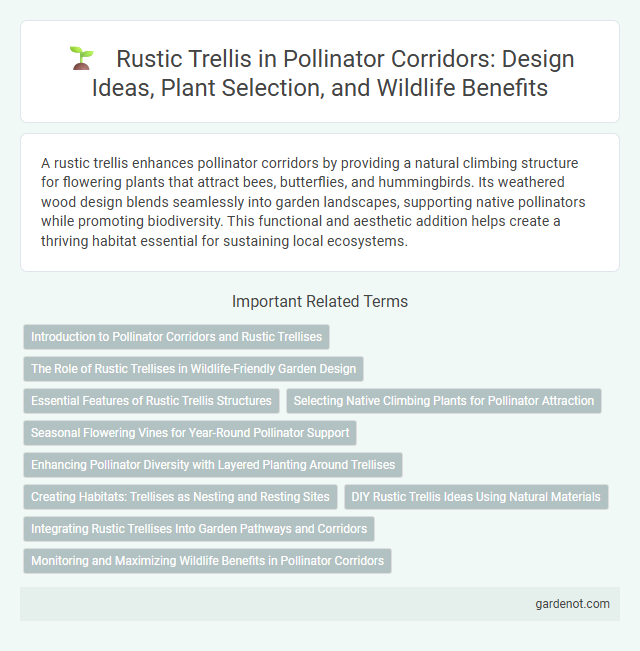A rustic trellis enhances pollinator corridors by providing a natural climbing structure for flowering plants that attract bees, butterflies, and hummingbirds. Its weathered wood design blends seamlessly into garden landscapes, supporting native pollinators while promoting biodiversity. This functional and aesthetic addition helps create a thriving habitat essential for sustaining local ecosystems.
Introduction to Pollinator Corridors and Rustic Trellises
Pollinator corridors are essential ecological networks that connect habitats, allowing bees, butterflies, and other pollinators to safely forage and migrate. Rustic trellises, constructed from natural wood materials, provide ideal structures within these corridors to support flowering vines and plants, enhancing nectar and pollen accessibility. Integrating rustic trellises into pollinator corridors promotes biodiversity by creating vertical habitat complexity and continuous food sources.
The Role of Rustic Trellises in Wildlife-Friendly Garden Design
Rustic trellises create essential vertical habitats that support pollinator movement and nesting in wildlife-friendly garden design. By providing native climbing plants a natural structure, these trellises increase floral diversity and extend blooming periods, enhancing foraging opportunities for bees, butterflies, and hummingbirds. Integrating weathered wood materials fosters an organic aesthetic while promoting ecological benefits such as improved habitat connectivity within pollinator corridors.
Essential Features of Rustic Trellis Structures
Rustic trellis structures feature natural wood materials that blend seamlessly into garden environments, providing strong support for climbing plants like clematis and honeysuckle. Their open lattice design ensures optimal airflow and sunlight penetration, essential for healthy pollinator habitats. Durable construction with weather-resistant finishes guarantees long-lasting functionality in outdoor pollinator corridors.
Selecting Native Climbing Plants for Pollinator Attraction
Rustic trellises provide an ideal framework for native climbing plants that attract pollinators such as bees, butterflies, and hummingbirds. Selecting species like Passionflower, Trumpet Vine, and Clematis ensures vibrant blooms that offer nectar and pollen critical for local pollinator populations. Incorporating these native climbers enhances biodiversity and supports sustainable ecosystems within pollinator corridors.
Seasonal Flowering Vines for Year-Round Pollinator Support
Rustic trellises serve as ideal structures for cultivating seasonal flowering vines that provide continuous nectar sources, attracting a diverse range of pollinators such as bees, butterflies, and hummingbirds throughout the year. Vines like honeysuckle, clematis, and trumpet vine offer staggered blooming periods, ensuring consistent pollinator activity and promoting ecosystem resilience. Incorporating these dynamic vertical elements into pollinator corridors enhances habitat connectivity and supports biodiversity across multiple seasons.
Enhancing Pollinator Diversity with Layered Planting Around Trellises
Rustic trellises support layered planting strategies that significantly enhance pollinator diversity by providing varied structures for different plant species, attracting a wide range of pollinators such as bees, butterflies, and hummingbirds. Integrating native flowering vines, herbs, and shrubs around trellises creates microhabitats that extend blooming periods and increase nectar availability. This layered approach boosts ecosystem resilience and promotes sustainable pollinator corridors essential for biodiversity conservation.
Creating Habitats: Trellises as Nesting and Resting Sites
Rustic trellises provide essential nesting and resting habitats for pollinators by supporting climbing plants that offer shelter and food sources. Designing trellises with natural materials enhances habitat suitability for solitary bees and butterflies, encouraging biodiversity within pollinator corridors. These structures promote ecological connectivity, facilitating safe movement and nesting for various pollinator species.
DIY Rustic Trellis Ideas Using Natural Materials
Creating a DIY rustic trellis using natural materials like reclaimed wood, bamboo, or grapevines enhances pollinator corridors by providing essential support for climbing plants that attract bees, butterflies, and hummingbirds. Incorporating moss, twine, and rough-hewn branches into the trellis design not only reinforces its structure but also offers textured surfaces for beneficial insects to rest and forage. Utilizing sustainable and locally sourced materials in rustic trellises promotes biodiversity while maintaining ecological balance within garden ecosystems.
Integrating Rustic Trellises Into Garden Pathways and Corridors
Rustic trellises enhance pollinator corridors by providing essential vertical structures that support flowering vines, increasing habitat diversity and nectar sources for bees, butterflies, and hummingbirds. Integrating these trellises along garden pathways creates continuous pollinator-friendly zones, facilitating movement and foraging efficiency. Strategically placing native flowering plants on trellises maximizes bloom visibility and sustains pollinator populations throughout growing seasons.
Monitoring and Maximizing Wildlife Benefits in Pollinator Corridors
Rustic trellises support diverse native plants that attract and sustain pollinators, enhancing habitat connectivity within pollinator corridors. Monitoring pollinator activity on these structures using timed observations and species counts helps assess their effectiveness in promoting biodiversity. Integrating varied floral species and structural complexity maximizes wildlife benefits by providing continuous forage and shelter for multiple pollinator species throughout the seasons.
Rustic trellis Infographic

 gardenot.com
gardenot.com